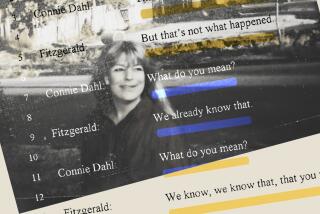Military Backtracks on Suicide Ruling : Marine: Parents of Capt. Jeffrey Digman, who have spent $80,000 trying to prove their son was murdered, consider the medical examiner’s decision to call the cause of death unknown a victory.
After re-examining 2-year-old evidence, the Armed Forces Medical Examiner has now ruled that it is unknown how Marine Capt. Jeffrey Digman died.
Digman was found dead in 1989, shot in the head in his Temecula home. Marine officials and the Riverside County coroner had said it was suicide. But Digman’s parents say it was murder.
“Somebody out there shot our son,” said Bill Digman, a retired engineer who lives in Cypress. “There’s a culpable person out there still walking the streets.”
Digman has spent $80,000 trying to prove the military wrong and to track the killer he believes shot his son and left him sprawled on his bed in a pool of blood.
Digman and his wife, Donna, have recreated the death scene in their home; they speak about bullet trajectories and blood spatters with newly acquired finesse. And, obsessed with unraveling the mystery, they have hired two detectives, four pathologists and one scientist.
For them, the recent ruling by the Armed Forces Medical Examiner, the highest in the chain of command, is a victory. They now plan to battle the decision to close the investigation.
In a letter to Bill Digman, Dr. Richard C. Froede, the Armed Forces Medical Examiner, said he reviewed coroner’s and Naval Investigative Service reports, photographs of the body, accounts of the two autopsies and an article published in The Times about the young man’s death.
“After careful examination and much thought, I have classified the manner of death in this case as undetermined based on these materials,” Froede wrote in a letter dated Feb. 22, 1991.
The Naval Investigative Service, however, has closed its investigation, and officials say they do not plan to reopen it unless new leads surface.
Froede’s pronouncement “doesn’t change anything for us. . . . That doesn’t throw a switch to do more or less with the investigation,” said NIS Regional Director Dennis Usrey in San Diego. “The investigation is closed, but that is not irrevocable. Upon the development of additional leads, we would reopen it.”
Usrey also says that every effort was made to solve the case. “We ran up every alley in trying to resolve this thing,” he said. “This thing was not kissed off. We put a lot of time into this case.”
Digman, 30, was found in his bedroom Jan. 22, 1989; blood stained the bedding and trickled down the sides of the brass bed frame. The young captain, who had worked at San Diego’s Marine Corps Recruit Depot, was assigned to Puerto Rico shortly before his death. He had returned to his Temecula home, which he shared with a former supervising officer, for a short visit.
At the time of his death, his blood alcohol level was .24--or more than double the legal limit for driving. In his evaluation reports, Digman is depicted as conscientious, honest, intelligent and tireless. A devoted runner, he usually jogged 10 miles a day. A quirky and meticulous man, Digman was so neat that he didn’t like friends to put glasses on his coffee table. Although described as an officer with a bright future, he was also nicknamed “Dr. Gloom.”
Yet Maj. Douglas K. Wood, co-owner of the house and Digman’s former supervising officer, told The Times last fall that the young man had no drinking problem and appeared neither suicidal nor depressed in the days before his death. But girlfriends have said that Digman was a heavy drinker.
The experts agree that it is a case of contradictions that may never be solved.
The Riverside County coroner’s office ruled Digman’s death a suicide but, puzzled by the circumstances, it asked the NIS six months later to step in.
“There were a lot of unanswered questions and circumstances we couldn’t account for,” said Riverside County Deputy Coroner Rick Bogan in an interview last fall. Bogan, who examined Digman’s body, later said he was instructed by his supervisors not to discuss the case. Bogan was unavailable for comment Tuesday.
When NIS agents launched their inquiry, the furniture had already been removed from Digman’s room, and the bedding had been tossed away. Agents had little physical evidence to examine and requested permission to conduct a second autopsy, which maintained the same conclusion as the first autopsy: suicide.
Using the mock-up in their home, the Digmans have demonstrated why they believe their son was the victim of a killer. The path of the bullet, where it has gone through the ceiling, and the location of the body don’t match up, they say--a major point that a team of experts hired by the couple also confirmed. The experts say the young captain was shot and placed on the bed.
“There are some unanswered questions and physical findings that are inconsistent with suicide,” said Dr. Cyril Wecht, a clinical professor of pathology at the University of Pittsburgh School of Medicine and a former past president of the American Academy of Forensic Sciences. Wecht and other experts hired by the family cited the following questionable circumstances:
* Digman was left-handed, yet he was shot above the right ear.
* The weapon found at his feet was a .44 magnum revolver, yet the wound was relatively small, inconsistent with that kind of powerful gun.
* Though it is unusual for a left-handed person to use his right hand to pull the trigger, it can be done. In these cases, the person usually steadies his aim by putting the gun up against his head, which would create a large star-shaped contact wound. The first coroner’s report described the wound as “near contact” and said it was not star-shaped.
* The trajectory of the bullet.
* The blood spatter on the wall is inconsistent with the bullet’s trajectory.
* Digman was found lying in a pool of blood with both hands by his sides, but there was also a blood smear on the sheets well above his head, beyond his reach.
These unexplained circumstances gnaw at the Digmans. Their son’s death has thrust them into a world of red tape and grief. Accepting death is difficult enough, they say, but it’s far more agonizing believing he has been murdered and being unable to prove it.
“Somebody shot Jeffrey; somebody killed him,” Bill Digman said. “He’s in a grave out there, and the most we can say is, ‘Jeffrey, we can’t find out how you died.’ ”
More to Read
Start your day right
Sign up for Essential California for news, features and recommendations from the L.A. Times and beyond in your inbox six days a week.
You may occasionally receive promotional content from the Los Angeles Times.






